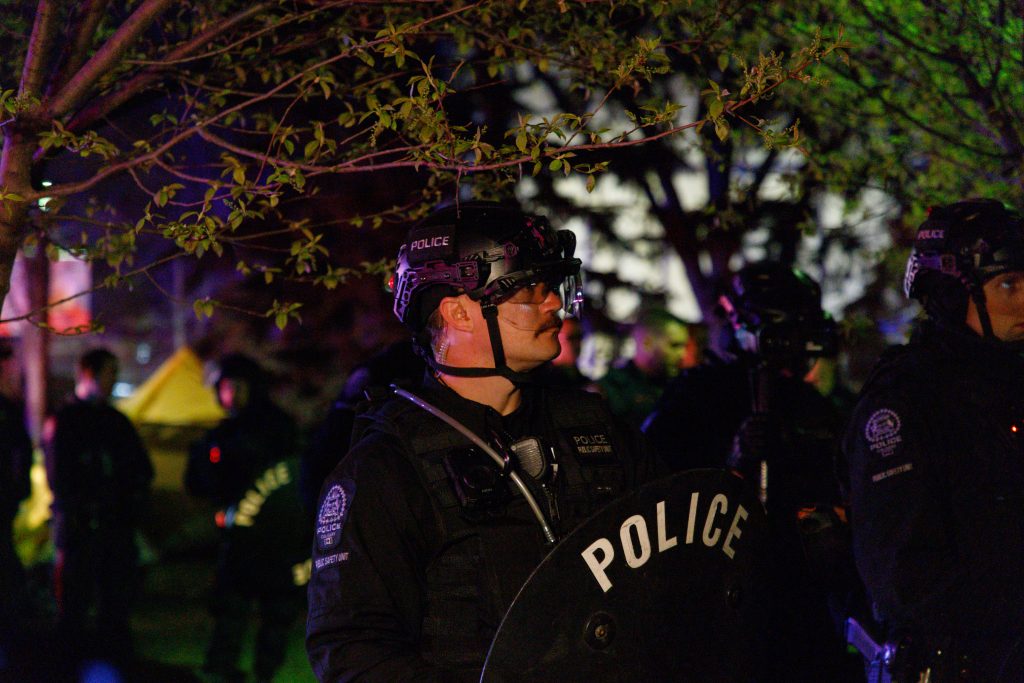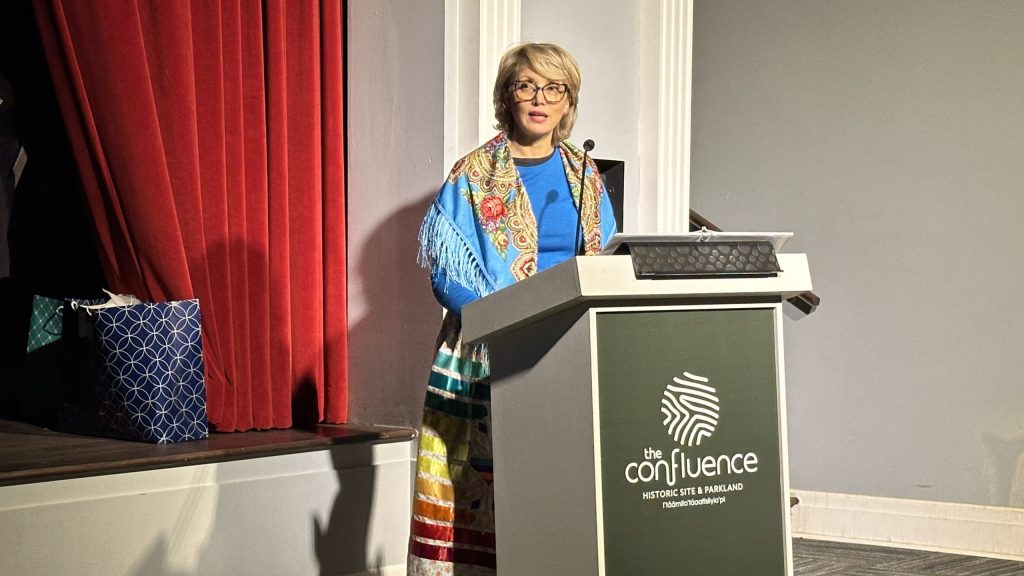The Air Up There: How Canadian basketball has grown and where it’s headed
Posted Oct 28, 2014 2:01 pm.
This article is more than 5 years old.
It’s July 2008 in Las Vegas where Team Canada and Team USA are playing an exhibition game ahead of the Beijing Olympics.
The respective heads of both programs, Jerry Colangelo for the USA and Wayne Parrish for Canada, are speaking and one says to the other, “I envy you.”
One would think it would be Parrish admiring Colangelo, but it was actually the opposite.
“We were losing by 50 points or something like that and I said, what the heck are you talking about?” Parrish remembered.
But Colangelo had noticed through his son Bryan, who then had taken over as Raptors general manager, the young talent being developed north of the border.
Now everyone has noticed.
On opening night, 13 Canadians were on NBA rosters, including the last two number one overall picks in Anthony Bennett and Andrew Wiggins, both playing for the Minnesota Timberwolves.
That list includes two-time MVP Steve Nash, who will not play this season because of nerve problems, but has yet to make an official announcement about retirement.
Three other Canadians were also cut from NBA rosters in the preseason: Sim Bhullar from Sacramento, Khem Birch from Miami and Brady Heslip from Minnesota.
In the last draft, Nik Stauskas was taken eighth overall by Sacramento, while Tyler Ennis went 18th by the Phoenix Suns.
The youth talent was also on display during March Madness last season, when 25 Canadians were on NCAA tournament rosters, many with pivotal roles for their teams.
Parrish said like any overnight success, it’s the result of many years of hard work by a lot of people with multiple factors contributing, with a key one being the presence of professional basketball in Canada.
“That really did lift the profile of basketball in this country from coast to coast and I think the Raptors have done their best through some difficult teams to maintain that since the Grizzlies have left,” he said. “That crystalized what was a developing interest in this sport at the grass roots level.”
It’s a notion the first president and CEO of the Raptors, Obelysk Inc. Chairman John Bitove, had long before he put in the bid for the team in the early 90s, as a child going to Maple Leaf Gardens when the Buffalo Braves would come to play every year and later on during his studies at Indiana University.
“It’s a religion down there and it opened me up to a whole kind of bigger world to what basketball really can be and that’s where I kind of said it; wow if Canadians ever really got to experience basketball, as a major cultural piece of phenomenon, they’d have a different appreciation for it and this past season with the Raptors was part of it,” Bitove said.
The sentiment is echoed by Rowan Barrett, executive vice-president and assistant general manager for Team Canada’s national men’s program, who before moving into the executive ranks, was a long-time member of the national team alongside Nash.
He said unlike his childhood where he grew up thinking he would be a sprinter before a basketball player, today’s generation of young Canadian athletes have had access he never imagined.
“This is the first group of athletes we’ve had in our country that have grown up with the NBA in their backyard, where they’re seeing multiple games each week, where they are having an opportunity to go down to the arena and go and see what this looks like,” Barrett said.
One of those athletes was Kevin Pangos, now a senior guard at Gonzaga University and three-time All-WCC team member, who grew up in Holland Landing, Ontario playing hockey and soccer, with basketball third in line.
He knew he wanted to be some kind of professional athlete and the influence of the Raptors was paramount.
“It was huge,” Pangos said from Gonzaga. “Having the Raptors to watch and look at and having guys like Steve Nash playing in the NBA and be so successful, it made that dream and that goal more possible in my mind.”
“Every night the Raptors were on, I’d tune in and go to some games occasionally and just kept that dream alive.”
This continued growth and attention also occurred over years where the Raptors saw limited success, but exploded when the team surged last season and went seven games with the Brooklyn Nets in the first round of the Eastern Conference playoffs.
That series became the most watched NBA playoff series in history in Canada, with an average of 732,000 viewers, including an average audience of 912,000 for Game 7 and a peaked level of over two million people.
More viewers watched Game 5, where Toronto took a 3-2 series lead, than all three NHL Game 7s that night, however it should be noted no Canadian team was playing in those contests.
Along with the presence of the team, Parrish, Barrett and Bitove all point to Canada’s immigration patterns as another major reason for increase in the game, which according to recent data, continues today.
According to a June 2014 study by the SRG Group, basketball is the second-most popular sport among new Canadian youth, next to soccer.
The next two were hockey and volleyball and the study says with over one million immigrants settling in Canada every four years, “establishing a strong base among new Canadians is essential to the future growth of any sport in the country.”
Parrish believes that base is very firm.
“We have been the beneficiaries of a lot of immigration over the last 30 years or more that has come from areas where basketball is a cult, if not a religion,” Parrish said. “Basketball is the number one sport for youth in west Asia, the number one sport in south Asia, it’s a big sport in the Caribbean countries.”
The trend is clear when looking at the nationalities of Canadian pros, with backgrounds spanning from all parts of the world.
Bennett’s family moved from Jamaica, as did Cleveland Cavalier and 2011 fourth overall pick, Tristan Thompson.
Other Carribean roots include Wiggins, whose mother is from the Barbados, New York’s Samuel Dalembert who is originally from Haiti and Detroit’s Joel Anthony’s family is from Antigua.
Among other regions, Melvin Ejim who recently wrapped up his career at Iowa State and is playing in Italy, is Nigerian, while Bhullar’s parents moved to Canada from India in 1988.
Although Bitove said he always knew the game would succeed, he admits he didn’t see this side effect coming.
“I never really realized how impactful it would be to the point where you could have an Olympic team in the games that has all NBA players on it or have two number one picks,” Bitove said.
Parrish and Barrett also point to continued coaching development and having young Canadian athletes travel and compete in the AAU circuit over the years as other critical points of growth.
Programs such as CIA Bounce and Grassroots Canada have featured many current NBA players and not only grew to the point of competing with American competition, but outplaying them.
“What you’re getting now is our players that have been playing for all these years, they have the repetition and they’ve been on the circuit, they’ve been playing in the American environment and they’re playing against players that they’ve been beating on the circuit for years,” Barrett said. “So when they go into the NCAA, they’re going and not only knowing that they can play, but they’re going and knowing that they’ve dominated many of the players they’re going to play against.”
Although the reality of today had seemed unattainable five or 10 years ago, Pangos said the idea was something he and his colleagues often discussed.
“I remember back to when me and Nik used to go to camp together and play one-one-one for hours and hours and then you seeing guys like Wiggy and Bennett in Minnesota doing so well, Cory (Joseph), Tristan, there’s just so many guys right now,” he said. “We all kind of dreamt about it and it was everyone’s goal and we were confident that we could possibly do it.”
As for developing the game in western Canada, with such a major contingent of players coming out of Ontario and Quebec, Parrish says TV ratings for the Raptors will be imperative, but he’s also counting on the next generation of players growing up with the game.
“We’re always going to be hockey first, I don’t think any of us have any illusions around breaking down that,” he said. “As hockey becomes more and more expensive, as the concussion problem continues to work its way through the system and solutions are still being searched for, I think you’ve got that potential that within the next five to ten years, there’s another level of breakthrough that basketball has.”
On the financial side, the SRG data studying 44 sports, also reports hockey is the second-most expensive in Canada behind water skiing, whereas other team sports such as basketball, volleyball and soccer cost 25 to 50 per cent less.
But along with getting more viewers and young athletes in grassroots programs, a major focus is Canada on the international stage, including both men’s and women’s programs in the 2016 Olympics, as well as 2020, which for Barrett is a major source of pride.
“We’re all born here, we’re all raised here, this system has grown us and to go in the NCAA or go to the NBA and not come back and represent that country, is not something we ever want to be known for,” Barrett said. “If one of the marks of Steve’s legacy, our legacy will be that we tried to push the game further when we played and we moved out of playing, but tried to focus our young talent to make sure that it comes back and gives back.”
On the women’s side, Canada is coming off a fifth-place finish at the 2014 World Championships in Turkey and fans will be able to cheer them on home soil in Edmonton for the 2015 FIBA Americas Championship, with the winner automatically qualifying for the 2016 Games.
“It is the biggest event on Canadian soil since the late 1990s, it is the ultimate showcase,” Parrish said. “That home-field advantage is so important in an international tournament, to have those hometown fans behind you.”
For the men, they will have to compete in the FIBA Americas tournament in Mexico, going up against the likes of Argentina and Brazil.
The U.S. has already qualified by winning the World Cup this summer and it’s assumed Brazil will also qualify as the hosts, increasing Canada’s chance at a top-two finish and an Olympic berth.
But there’s also a major focus on the 2020 Games in Tokyo, where the young athletes will have had five more years of professional development.
Then there’s rising stars such as Olivier Hanlan, who was the 2013 ACC Rookie of the Year for Boston College and Oregon Duck Dillon Brooks who led this summer’s U-18 FIBA Americas tournament in scoring at 25.2 ppg as Canada won silver.
Brooks’ teammate on that team, Montaque Gill-Caesar of the Missouri Tigers, was second in scoring for the tournament and Toronto’s Jamal Murray is attracting several major big programs in the NCAA.
Pangos said considering what’s happened over his teenage years and looking to the future, he believes the best is yet to come.
“We’re not satisfied with where we are, everyone wants to become one of the bigtime countries in the world for basketball with the United States, with Argentina and Spain and be in that conversation,” Pangos said. “We still got a lot of young guys, but I think that’s what everyone’s goal is, to just make a statement throughout the world.”










